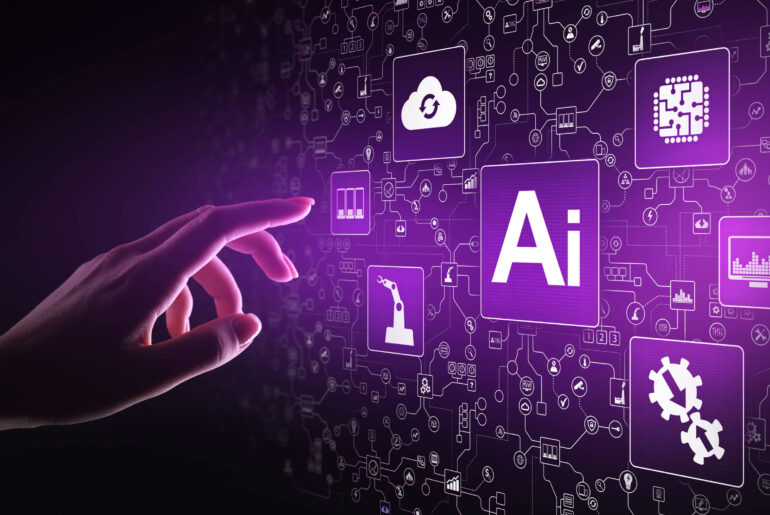As dawn breaks over a world veiled in digital progress, we stand on the precipice of an era dominated by Artificial Intelligence (AI), the newest bigwig shaping up to be the leviathan of technological advancement. Gazing at this changing horizon, where algorithms learn, evolve and execute dynamically, one thing is increasingly clear – AI is not just part of the future; it’s stitching itself into the core fabric of what will become our new normal. Brace yourself as we delve deeper into how AI is redefining innovation and transforming every sector across the globe, promising a trajectory that could supersede anything humankind has witnessed before. This quantum leap in technology is no longer confined to the realms of sci-fi—it’s here, now. And it’s not just changing the game; it’s rewriting all the rules.
Artificial intelligence is poised to play an increasingly significant role in shaping the future of technology. As computing power continues to increase, AI will drive advancements across a variety of industries, including big data, robotics, IoT, and generative AI. AI is already transforming major industries such as transportation, healthcare, education, and customer service by accelerating decision-making based on massive amounts of data. While there are some concerns about job displacement due to automation, retraining programs and investment in education can ensure that society realizes the full potential benefits of AI integration. Overall, AI promises to enhance our lives with unprecedented speed and efficiency while setting new standards for productivity and innovation.
An Overview of Artificial Intelligence
Artificial Intelligence (AI) has become one of the most revolutionary technologies of our time, with its impact permeating various sectors and industries. But what exactly is AI? At its core, AI refers to the development of computer systems that possess the ability to perform tasks that typically require human intelligence. These tasks can include learning, problem-solving, decision-making, and even speech and image recognition.
AI operates through the use of algorithms and vast amounts of data, enabling machines to learn from patterns, make predictions, and adapt their behavior accordingly. It encompasses various subfields, such as machine learning, natural language processing, computer vision, and robotics. By mimicking human cognition, AI aims to enhance efficiency, improve accuracy, and create new possibilities across diverse domains.
To illustrate the power of AI, consider the field of healthcare. With AI-powered diagnostic tools, doctors can analyze medical images more accurately and efficiently than ever before. Medical chatbots can provide preliminary assistance to patients by assessing symptoms and offering advice. AI algorithms can even sift through vast amounts of patient data to identify potential risk factors or predict disease outbreaks.
However, it’s important to note that AI is a broad term that encompasses both narrow or weak AI and general or strong AI. Narrow AI refers to systems designed for specific tasks like autonomous driving or virtual assistants. On the other hand, general AI aims to replicate human-level intelligence across a wide range of cognitive abilities. While we’ve made significant advancements in narrow AI applications, achieving general AI remains a complex challenge.
Now that we have a foundational understanding of AI, let’s explore some prominent advancements within this fascinating field.
- A 2022 survey by Statista showed that almost 84% of enterprises believe investing in AI will lead to greater competitive advantages.
- The International Data Corporation estimated global spending on AI systems to reach around $98 billion by 2023, representing an increase of approximately 120% over a span of five years.
- According to Gartner’s AI business value forecast, AI-derived business value is projected to reach up to $3.9 trillion by 2025, primarily driven by customer experience, new revenue, and cost reduction.
Prominent AI Advancements
Over the years, numerous breakthroughs in artificial intelligence have pushed the boundaries of what was once considered possible. Let’s delve into a few notable advancements:
One significant area of progress is machine learning, where algorithms can improve their performance by learning from data. Deep learning, a subset of machine learning, utilizes neural networks with multiple layers to process complex information and extract meaningful patterns. This has facilitated advancements in image and speech recognition, natural language processing, and even autonomous decision-making.
Another key advancement is the integration of AI in robotics. Intelligent robots now possess the ability to navigate their surroundings, interact with humans, and perform intricate tasks with precision. These automated systems are being utilized in industries such as manufacturing, healthcare, agriculture, and space exploration.
AI has also made significant strides in natural language processing (NLP), enabling machines to understand and generate human language. Voice assistants like Siri and Alexa demonstrate NLP capabilities by comprehending spoken instructions and providing relevant responses. This technology has also found its way into translation services, chatbots, and sentiment analysis tools.
Furthermore, AI has revolutionized the field of computer vision, enabling computers to interpret images and videos with immense accuracy. Object recognition and tracking have become fundamental components in industries ranging from autonomous vehicles to surveillance systems.
It is evident that these advancements only scratch the surface of what AI is capable of achieving. As we delve deeper into AI’s impact on various industries, we’ll witness how this technology transforms the landscape of innovation.
- Artificial Intelligence has made significant advancements in machine learning, robotics, natural language processing, and computer vision. These achievements have facilitated numerous breakthroughs, including image and speech recognition, autonomous decision-making, precision robotic tasks, voice assistants, and object recognition. With AI’s transformative impact on various industries, we can expect its continued growth and evolution in the coming years.
AI Impact Across Industries
Artificial intelligence (AI) has become a transformative force, extending its influence across various industries. From healthcare to transportation and education, AI is revolutionizing the way we live and work. Its impact is far-reaching and promises substantial advancements in innovation.
In the realm of customer service, businesses are leveraging AI-powered chatbots to provide quick and efficient responses to customer inquiries. These chatbots utilize natural language processing (NLP) algorithms to understand and respond to customer queries, saving valuable time and resources for companies while improving the overall customer experience.
Imagine contacting a company’s customer support line and having your query instantly answered by an intelligent chatbot capable of understanding your needs, providing relevant information, and potentially resolving issues without the need for human intervention.
Another industry experiencing the transformative power of AI is manufacturing. By integrating AI technologies into production processes, manufacturers can optimize efficiency, improve quality control, and reduce costs. With machine learning algorithms and predictive analytics, AI enables better forecasting of demand, thereby minimizing waste and streamlining inventory management.
| Industry | AI Application |
|---|---|
| Customer Service | AI-powered chatbots for quick customer query resolution |
| Manufacturing | Machine learning algorithms for demand forecasting and inventory |
| Transportation | Self-driving vehicles for enhanced safety and improved logistics |
Just as AI is the fuel powering the engine of innovation, it serves as the brain behind self-driving cars, transforming the landscape of transportation. Self-driving vehicles equipped with advanced sensors, computer vision, and machine-learning algorithms navigate roads more efficiently than human drivers. They promise enhanced safety through reduced human error and improved traffic management, ultimately leading to increased productivity.
“Transportation has never been so effortless, with self-driving cars taking us from point A to point B while we relax, catch up on work, or enjoy a good book.”
Now let’s dive into the impact of AI on healthcare, where innovation is transforming patient care and driving medical advancements.
Healthcare Innovations via AI
The healthcare industry is ripe with opportunities for AI to have a significant impact. One of the areas where AI demonstrates immense potential is in medical imaging analysis. By utilizing deep learning algorithms, AI can analyze medical images such as X-rays, MRIs, and CT scans with astounding accuracy. This allows for quicker diagnosis, early detection of diseases, and improved treatment planning.
Furthermore, AI-powered virtual assistants are revolutionizing the doctor-patient relationship by enabling remote patient monitoring and triaging. Wearable devices equipped with sensors collect vital signs and health data that can be transmitted to healthcare professionals in real-time. This enables proactive interventions, personalized treatment plans, and efficient use of resources.
AI also plays a crucial role in drug discovery and development. With vast amounts of data available, machine learning algorithms can sift through this information to identify potential drug candidates and predict their effectiveness. This accelerates the drug discovery process, leading to more targeted therapies and improved patient outcomes.
Consider patients with chronic illnesses who can now receive personalized treatment plans based on their unique genetic profiles and medical history. This level of precision medicine would have been unimaginable without AI’s ability to interpret complex data sets and provide actionable insights.
AI in Transportation and Education
Artificial Intelligence has made significant strides in transforming various industries, including transportation and education. In the transportation sector, AI is revolutionizing the way we move people and goods, improving safety, efficiency, and sustainability. Self-driving cars utilizing AI algorithms are being developed to reduce human error and enhance road safety. These vehicles can analyze vast amounts of data from sensors and cameras to make intelligent decisions on navigation and avoid potential accidents.
Transportation companies are also using AI-powered solutions to optimize logistics operations. AI algorithms can analyze historical data to predict demand patterns, helping companies streamline their supply chains and reduce costs. Additionally, AI-powered traffic management systems can alleviate congestion by optimizing traffic flow through real-time analysis of traffic data and suggesting alternate routes.
In the education domain, AI is reshaping the learning experience for students and educators alike. Intelligent tutoring systems powered by AI technologies provide personalized learning paths based on students’ strengths, weaknesses, and learning styles. These systems leverage natural language processing and machine learning algorithms to converse with students, provide instant feedback, and adapt instructional materials to individual needs.
AI chatbots are becoming increasingly prevalent in educational institutions to assist with administrative tasks, answer student queries, and provide information round-the-clock. This enhances operational efficiency by reducing the workload on staff members while offering timely support to students.
For instance, an AI-based virtual teaching assistant can be programmed to answer commonly asked questions about course schedules or assignments promptly. This frees up professors’ time to focus on more critical aspects such as lesson planning and student engagement.
Efficiency improvements in transportation and education due to AI technologies have far-reaching implications. They not only optimize existing processes but also unlock new possibilities for innovation. By automating repetitive tasks through chatbots or smart systems, professionals in both industries can allocate their time towards more strategic decision-making or creative endeavors.
With a better understanding of how AI is making its mark in transportation and education, let’s explore the overarching potential of AI in boosting efficiency across various sectors.
The Elevated Efficiency and Potential of AI
AI holds immense potential to elevate efficiency levels across various industries. By leveraging advanced algorithms and machine learning capabilities, AI systems can process vast amounts of data with unprecedented speed and accuracy, enabling organizations to make informed decisions quickly.
In the healthcare sector, AI is transforming diagnostics by analyzing medical images like X-rays or MRIs to detect abnormalities and help doctors make accurate diagnoses. This accelerates the identification of diseases, leading to timely treatment interventions. In pharmacy operations, AI-driven automation can optimize inventory management, improve prescription accuracy, and even predict medication demand patterns.
Financial institutions are also embracing AI for fraud detection and prevention. Machine learning algorithms can identify patterns of fraudulent behavior in large datasets, enabling proactive measures to protect both customers and financial institutions. Furthermore, AI-powered chatbots assist customers with basic inquiries or transactional processes, reducing wait times and enhancing customer satisfaction.
For example, virtual assistants powered by AI can analyze a customer’s transaction history to provide personalized recommendations for financial planning or investment options.
Furthermore, AI plays a pivotal role in optimizing manufacturing processes. With predictive maintenance algorithms that monitor machine performance and proactively identify potential faults, companies can avoid costly downtime while maximizing equipment lifespan. AI-powered quality control systems analyze product defects in real-time, helping manufacturers identify issues early on and rectify them promptly.
The potential of AI extends beyond individual industries. Its capability to process huge volumes of information enables cross-industry insights and innovations that were previously unimaginable. From smart cities that optimize energy usage and urban planning to personalized marketing campaigns driven by AI-powered analytics software, the possibilities for improving efficiency through AI are endless.
Having explored some notable examples of elevated efficiency through AI implementation, we have witnessed just a glimpse of the transformative power this technology possesses.
Understanding AI’s Automation Potential
Artificial Intelligence (AI) has emerged as a transformative force, reshaping industries and revolutionizing business operations. One of the key aspects that makes AI so powerful is its automation potential. By harnessing advanced algorithms and machine learning, AI systems can automate repetitive tasks, streamline processes, and enhance efficiency in ways that were previously unimaginable.
To grasp the true potential of AI automation, let’s consider a practical example. Imagine a customer service department flooded with numerous queries and requests from customers on a daily basis. Traditionally, these queries would require manual sorting, categorization, and response handling by human agents, resulting in longer response times and potential errors. However, with AI automation, natural language processing algorithms can analyze and understand customer queries, generate appropriate responses or route them to the right department without any human intervention. This not only saves time but also ensures faster and more accurate customer service experiences.
Another scenario where AI automation shines is in manufacturing. Robots equipped with AI abilities can perform complex tasks with precision and speed. They can seamlessly handle repetitive assembly line activities that were previously done by human workers, reducing costs while increasing overall productivity. In this way, AI-powered automation allows businesses to optimize their operations and allocate human resources to more creative and value-added tasks.
It is important to note that the potential for AI automation extends beyond routine tasks. With advancements in machine learning and deep learning techniques, AI systems can now analyze vast amounts of data to identify patterns, predict trends, and make informed decisions in real-time. This opens up opportunities to automate decision-making processes across various industries, such as finance, healthcare, logistics, and marketing.
However, it is worth acknowledging that while AI automation offers immense benefits in terms of efficiency and productivity improvements, there are valid concerns regarding its impact on employment. As AI continues to automate tasks traditionally performed by humans, questions arise about job displacement and the need for upskilling and retraining the workforce to adapt to this technological shift.
Navigating Potential Risks of AI Technology
While the potential benefits of AI technology are vast, it is crucial to address and navigate the potential risks associated with its adoption. One significant concern revolves around ethical considerations and biases within AI systems. Since AI algorithms learn from existing data, if that data is biased or contains prejudiced information, it can lead to discriminatory outcomes or reinforce existing biases in decision-making processes.
Think of a machine learning algorithm being trained to recruit new employees based on historical hiring data that includes gender bias. If left unchecked, this AI system could perpetuate discriminatory practices by favoring certain genders over others, leading to an unfair hiring process.
Another area of concern is privacy and security. As AI relies heavily on data collection and analysis, there is an increased risk of compromising individuals’ privacy rights if adequate safeguards are not in place. Unauthorized access, data breaches, and misuse of personal information are genuine threats that must be addressed to ensure the responsible and ethical use of AI technology.
Moreover, the potential for job displacement due to automation raises concerns about socioeconomic implications. While AI automation can streamline processes and boost efficiency, it may also result in some roles becoming redundant. This calls for proactive measures such as providing training opportunities for affected workers to acquire new skills or facilitating the transition into alternative roles that require human judgment and creativity.
Furthermore, ensuring transparency and accountability in AI systems is essential. Decision-making processes carried out by AI algorithms should be explainable and auditable to build trust among users and mitigate any potential harm caused by opaque or biased decisions.




